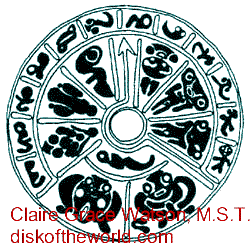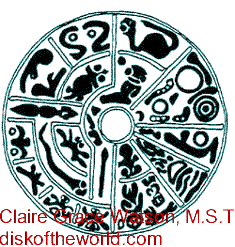
Dagon-Jah sits at his pottery wheel and makes pottery all day long, then awaits his master's entrance into the little hut to bring him the evening's meal. He hopes his master doesn't notice he is not making the commission pieces but is instead working on a creation of his own. It's a piece of pottery he hopes will earn him fame and fortune. Then he won't have to be an apprentice anymore. He can be a master. He hears Jah's voice tell him how to build the piece according to certain dimensions. It could be the masterpiece of his time. They might come from miles around to see it.
But what if they don't come? What if his masterpiece goes by the wayside with all the other pieces of pottery? If that happens he won't hear the applause he longs to hear. The voice tells him, "Don't worry about that, just create it. Give it to Daedalus. He will know what to do."
He works secretly on his masterpiece. It is a small round disk made of red clay, only six and a quarter inches diameter. He makes it small so he can hide it from his master. Because it is so small the work is very detailed. The disk has two inscribed sides, each with a big spiral of five rings.
The spirals are divided into 60 line segments, 30 on one side and 30 on the other side. Divided among the line segments and covering the disk on both sides are 240 tiny pictographs etched using 48 different designs. 37 are intended to appear identical and are repeated; 11 are single etchings into the clay. Dagon-Jah made the little designs and etched them precisely on both sides of the disk. He keeps this design invention a secret. It is only for his masterpiece and for nothing else.
But what if his masterpiece goes unrecognized? What then? Must he let the sands of time wear it down and erode it away? No, there must be a way to keep it safe. If he bakes it in the sun like the rest of the pottery, it will break apart over time and be lost. What can he do to preserve it for all time? He must preserve it, Jah's voice tells him. He must think of a way to keep it safe. It is too important to lose.
Months go by while secretly he builds a furnace to harden the disk so nothing can hurt it, so water cannot damage it, and if it is dropped it might not even break. When the time comes, he builds a fire in the furnace and stokes it with wood until the flames leap up and the wood becomes fiery coals. He puts the disk inside the furnace and watches as the fire burns the disk but, miraculously, the disk is not consumed by the fire. He tells no one of his invention of the kiln. It is only for his masterpiece.
By way of creating his masterpiece he has invented two technologies unheard of in the Bronze Age and he keeps them both a secret. They never will find out. He is one of the greatest inventors of his time, but he doesn't realize it because it's not what he set out to do. He only means to make his masterpiece so he can become a master.
The year is 1600 B.C.E., nearly four thousand years ago. The place is the town of Phaistos on the island of Crete in the Aegean Sea.
Dagon-Jah carefully packs the masterpiece in his roll-away and stows it on his back. He has high hopes of finding Daedalus at the Palace of Knossos. He will make the journey on foot in two days. With the festival of Dio-ysis coming up, it is a certainty he will have companionship along the way. Good companionship is always pleasant for Dagon-Jah. He is a talkative person when away from the potter's wheel. It will be a nice break from work.
His master, a good man, gives him leave to attend the festival and the bull sports at Knossos. Dagon-Jah of course does not reveal his real mission - to show Daedalus his masterpiece. The master might want to see it and then he would insist on knowing how it was created. Dagon-Jah destroyed the kiln after creating the disk. He had to be sure no other work of art would ever be created using his secret method. It would be a sacrilege.
He sets off on his journey to Knossos and soon meets a man he begins to admire. It is a fellow potter named Ja-Ra. This man wants to know what Dagon-Jah has in his roll-away that is so special. He notices how Dagon-Jah keeps touching it and adjusting it. Dagon-Jah is tempted to show him but he doesn't. The man admires Dagon-Jah for his reserve in revealing his secret. He is an honorable man. They both are.
They soon are joined by a sailor named Theseus, who falls in step with them. He inquires after their health and whether they plan to stay for the bull sports. Dagon-Jah says he hopes to stay. Ja-Ra also hopes to stay. Next, they are joined by a young woman named Ariadne, a bull leaper, on her way to Knossos to perform bull leaping in the central court of the palace. The men admire her courage and physical strength. She hopes to find a friend in Knossos, an athlete who taught her how to leap bulls. These newfound friends walk along under a beautiful blue sky. Stretching out all around them are the pale plains and rocky, gray plateaus of Crete, wonderful against the blue sky.

As they camp that night near the rock and shell path, they tell stories to the group and everyone pretends to be amazed, out of politeness. But when Dagon-Jah tells his story, the amazement is real.
Dagon-Jah was educated in a Cretan pottery factory in Egypt. One day the pharaoh come into the factory to select pottery. Dagon-Jah can't remember a day in his life that stands out as much as that day.
"The pharaoh stood tall among us, as though elevated by his great soul. When he passed by our group, he stopped and admired the piece I created. He reached out his hand, all covered in rings and bracelets of green and red and blue stones, and he touched my piece of pottery, selecting it as his.
His touch alone elevated me instantly to status of apprentice, and I was given a choice where I wanted to work. I chose Phaistos. I had been there once while working on a sailing ship. I was born there but was taken away as a baby to be raised with my parents in Egypt. My choice was to return home. I presented myself to my master who required I demonstrate my skill as a potter. I won his approval. I have a gift, they say. The pharaoh saw it in me."
Everyone is silent. Dagon-Jah had seen the pharaoh! He had been selected out by the pharaoh! It was more than any of them could imagine. They gained a new respect for this man who is so simple, carrying only a roll-away on his back and no stick or wand. They see him with new eyes.
On the second day, the road to Knossos becomes filled with travelers on the way to the festival. Many of them carry trumpets made of large sea shells. They will blow them during the festival to call Dio-ysis, the god with the bull's foot, out of the water. Many of them also carry a long thyrsuses, a wand made of bamboo and wrapped in ivy with a pine cone at the top. They carry it in honor of Dio-ysis, who also carries one, and in honor of the ancient oracles at Dodona, who carry the wands.
When the trumpeters evoke Dio-ysis at the festival, the gaiety will swell and fill the palace. Only the white bull will be oblivious, for everyone else will laugh and play and drink the wine of the god. Dagon-Jah begins to regret not having a trumpet or a wand but he reminds himself of his reason for going to Knossos.
"Ur Nammu will come," says Ariadne. Ur Nammu is the new god the people create as they turn away from the old gods.
"And so will his daughter, Ur Darukin," says Ja-Ra. "Ur Troda, his son, will come too. Him I worship."
Dagon-Jah says nothing. He is not a follower of the new gods. He still worships Jah and Re-Ah, the old ones. Re-Ah is the dark goddess of the deep night sky. She is the mother of Jah, the god of the created world. She shines above as the blue star. She looks down on Dagon-Jah and smiles at him. She encourages him to hear the voice of her son Jah. She is always watching over them and she always will be. Around her in the sky are the other shining ones, the shields -- the planets. They revolve around her and keep her safe.
Dagon-Jah will visit her cave when he leaves Knossos. Her cave is on the Earth and also in the night sky. He can see it shining up there, her sky cave. He will make an offering to her of a special piece of pottery he created just for her. It is a smiling woman wearing a flounced skirt with her blouse open at the top. Dagon-Jah is very good at small pieces of pottery and tiny models of large things. He is used to making pottery like this. Perhaps Re-Ah will like his piece of pottery and do him a favor. She will help him become a master instead of just an apprentice.
Dagon-Jah cannot understand why the people follow the new gods when the old ones love them so much but he says nothing of this to Ariadne, Theseus, and Ja-Ra, whose name tells him he also worships the Egyptian sun god. Dagon-Jah wants none of this. The daytime gods are for fools. The nighttime tells the truth of the old ones.
Jah is the loving god, the kind god. He is the one who cares for them and hopes them well. He is the one who sends friends to guide Dagon-Jah and watch over him. These tall friends he calls Watchers because they tower over him at night and watch him. They make sure no harm comes to him, but they never sleep.
As Dagon-Jah sleeps, he dreams of the fame that comes from being the greatest potter of his time. As he dreams he sees the Watchers guarding him in his sleep. They stand so tall above him their heads touch the midnight blue sky and their eyes twinkle like stars.
Dagon-Jah, Ja-Ra, Ariadne, and Theseus admire the vast Palace of Knossos, its four-story tall rooftops covered with bull's horns, its levels supported by long rows of upside-down Doric columns. The two-story Phaistos Palace is huge, thinks Dagon-Jah, but nothing to compare with this. Surrounding the palace is a carefully designed city of two, three, and four-story adobe townhomes decorated with rooftop patios, tiled floors, and painted with gay frescoes. The city streets are filled with sophisticated people wearing beautifully designed, colorful clothes. Many women are topless in their ankle length dresses, as are many men in their mini-skirts. The sophisticates mingle in the town and walk along roads paved with pebbles and shells. The Palace of Knossos and the city surrounding it are a shining metropolis in the Mediterranean Bronze Age. As the group approaches the palace, they cross over an expansive stone viaduct built over a flowing stream. The viaduct leads to the southwest entrance. Crowds of people cross with them, some carrying litters with bejeweled ladies inside, some walking with their children, some herding sheep, and some casually strolling along the promenade. The country people entering the palace are less stylishly dressed and wear shirts, blouses, or tunics and long pants. They come from the local countryside or from some of the other ninety towns and cities of Crete. "Daedalus designed this bridge," says Theseus, in a tone of respect. "Daedalus designed this palace," says Ariadne. The huge palace is built in a square around the continuous activities of its vast central court, where it hosts fashion shows, art fairs, markets, and rodeos. The palace has eight hundred rooms and covers six and a half acres. Ultra-modern in the Bronze Age, the palace has indoor plumbing with bathtubs and flushing toilets. Beneath the palace in a subterranean, labyrinthine plumbing and drainage system, water flows throughout in clay pipes large enough for a tall man to stand in. The Queen's bathroom, located in the Royal Apartments, has five entrances and walls tiled in blue dolphins and spirals. The Queen enjoys a garden tub and steam room. The palace architect, Daedalus, took special care in designing the Queen's bathroom. She is his patroness, although he serves the King as well.
Dagon-Jah and his traveling companions enter the palace only after stopping at one of the bathhouses to wash their faces, arms, and feet. They enter the palace through one of the shield rooms, its walls painted with blue, red, and yellow spirals and hung with huge Figure 8 shields. The entire ceiling is covered with interweaving blue spirals. In the corner, on a three-tiered tiled platform, stands a six-foot tall double axe, symbolic of the reign of the labyrinth kings. Dagon-Jah sees the Figure 8 shields and the double axe and thinks of his masterpiece and smiles. The four companions gather around a large incense furnace in the center of the shield room and are attended by a priestess who fans the incense to cleanse their spirits so they will be clean on the inside and the outside.
They enter the palace along a walkway supported by upside-down Doric columns painted red and black. Beautiful murals and frescoes cover the walls, large scenes depicting blue monkeys eating fruit and blue birds on limbs of white flowers. One of the larger murals is of a man gathering saffron, his dark brown body blending beautifully with the red and white background of flowers he bends over to pick. A masterpiece, thinks Dagon-Jah, who then is reminded of his own masterpiece. The columns and walls are covered in mazes and spirals that tell stories with images in continuous representation. Dagon-Jah stops to ask directions of a guard.
"Tell me, where can I find Daedalus?" "What is your name?" asks the guard. "Dagon-Jah." "And what do you want with the King's inventor?" asks the guard. He is magnificent with his crested helmet and his ornately engraved sword. The engraving shows dogs chasing a lion. His shield is engraved with a battle scene showing Egyptian chariots. He is dark and his dark eyes seem to penetrate Dagon-Jah's soul. No one would dare refuse to answer the guard's questions. "I am told to see him," says Dagon-Jah. "Who told you?" "Jah told me." The guard looks closely at Dagon-Jah. The name Jah is like a password. "I will take you." He leads Dagon-Jah through the crowd that parts to let them pass. They enter the building opposite the great facade of central court where hundreds of people mill about talking. They walk up a covered walkway supported by columns. Ten steps lead to the room at the top. The guard knocks on the door with the hilt of his sword, and a small, delicate man opens it. Could this be Daedalus? How could such a small man be so widely known? "This man, Dagon-Jah, is sent by Jah to see you," says the guard to the small man. Daedalus nods his head 'yes,' and Dagon-Jah is shown into the most remarkable room he will ever see. It is huge and filled with all kinds of devices he can't understand. Against one wall are giant wings made of white papyrus and at least ten feet tall. Against another wall is a device like a miniature chariot. Charts and maps cover the walls, and near the center of the room is a table upon which rests a big model of the great pyramid. Scattered throughout the room on the floor are pieces of clay plumbing pipes and fixtures, and in the center of the room is a big box shaped like a bull and painted white. Along the far wall and gathering dust is a giant miniature of the Palace of Knossos. The astonishment Dagon-Jah feels shows on his face. Daedalus laughs. "Here," says Daedalus, "look at this." He hands Dagon-Jah a tiny miniature of the entire Palace of Knossos, so small he can hold it in both his hands. The tiny replica is true to every detail. Even the murals are there and the tiny bull's horns top the palace all the way around. Dagon-Jah is afraid he will drop the replica and hands it carefully to Daedalus. As he does he sees leaning in a corner a mummy, its moldy face partly exposed. He cannot help but stare at it. "The mummy can teach me much about the human form and mechanism," explains Daedalus. "But don't tell anyone," he whispers to Dagon-Jah. "It's a sacrilege in Egypt even to unwrap the mummy. To dissect it is against the law of the land. I would soon be a mummy myself if they found out." Daedalus offers Dagon-Jah a seat and calls an attendant, who serves them bread and wine with olives. After giving Dagon-Jah time to refresh himself, Daedalus says, "Dagon-Jah, why has Jah sent you to see me?" Dagon-Jah smiles with pleasure. "Because I am Dagon, name of the fish-god. I am a follower of Jah. His name is Jahoveh but his friends call him Jah. His sign is that of the fish. He saw me making pottery shaped like a fish so he spoke to me. He gave me his name and he told me to make an image of his masterpiece. He told me how to make the furnace to preserve it and he told me it would not be consumed by the fire. He told me to take it to you. I have only done as Jah has told me to do." 'What is Jah's masterpiece?" asks Daedalus. "Jah's masterpiece is the fire that does not consume the disk of the world. He created the fire, then he created the disk of the world and he put it into the fire. The disk of the world is burning and so are all the people and things on the disk, but they are not consumed. This is Jah's Masterpiece." He removes the masterpiece from his roll-away.
Daedalus does not speak for nearly an hour. He studies one side of the disk and then the other. He traces the spiral on one side with his finger and then he tries the other side. He runs his finger across the raised images. He has never seen anything like this, not in Crete, not in Egypt, and not in Byblos. How could it have been done? And what of the hardness? How had it got so hard? All these thoughts run through his mind as he inspects the disk. Finally, he speaks. "Did you create this?" "Yes." "How was it done?" "I molded the clay and drew the spirals. I etched the images into the clay and made the impressions. Then, I made a hot fire inside a house of bricks and got it so hot the wood became burning coals. I made a stand to hold the disk inside the fire and I placed the disk on the stand. I baked it until I thought it might burn up, but it did not. I pulled it out of the fire, and there it is as you see it. Then, I destroyed the brick oven." "Dagon-Jah, who are you?" asks Daedalus. "I am a pottery apprentice with my master at Phaistos. Some of the pottery here was made by my hands. Much of the pottery painted with spirals was made by me." The Masterpiece of Dagon-Jah, Sides 1 and 2
"Only an apprentice," says Daedalus in disbelief. "You are a master." Dagon-Jah feels the wonderful warmth of recognition. "I hope you will stay with me a few days," says Daedalus. Dagon-Jah is overwhelmed with happiness. To stay with the famous inventor Daedalus is greater even than seeing the pharaoh. He gratefully accepts. "I want to solve this maze on your masterpiece," says Daedalus. "At the end of tomorrow if I have not solved it, will you show me how?" Dagon-Jah agrees, filled with joy that the great inventor has seen his intention of creating a maze puzzle. "Good. You may examine my collections while I solve your maze puzzle." The kindred souls settle in to enjoy their time together, Daedalus with the maze and Dagon-Jah with the wonderful inventions. One day passes and still Daedalus studies the disk but cannot solve the puzzle. He begins at the center of the spiral on one side and tries to go to the other side, but is cut off from the outside spirals. He cannot move from the center of one side of the disk to the center of the other side without being blocked. He cannot escape the maze. Must I put on wings and fly out, he thinks to himself? Finally, he asks Dagon-Jah to show him the solution, but before he does he calls his son Icarus in to view the solution. Dagon-Jah takes Daedalus out to central court where there is plenty of sand. He clears a small area of shells and rocks, then smoothes it over and pours water onto it. Very carefully he stamps one side of the disk into the sand, then turns it over and stamps the other side, overlapping them at the matching line segments. Daedalus can see right away the shape of the Figure 8 shield. Now, he sees the solution to the maze. The solution to Dagon-Jah's maze puzzle
He starts in the center of the spiral on side 1 and with his finger traces the spiral around and around until he crosses over from spiral 4 of side 1 to spiral 5 of side 2, then goes around and around until he reaches the center of side 2. Then, he traces the spiral back until he crosses over at spiral 4 of side 2 to spiral 5 of side 1 and goes around and around until he returns to the center of side 1. It was there all the time, so simple it was impossible to see. Dagon-Jah tells Daedalus, "This is the Disk of the World. It is the Masterpiece of Jah, who created it. Here is the world of Earth," says Dagon-Jah, pointing to side 2 of the disk. "These are the five levels," he says, pointing to the five spirals. "Here are all the people and all the things of Jah. Everything Jah creates is holy; the people, the children, the priests, the guards, the trees, the plants, the grass, the crabs, the fish, the vultures, the eagles, the flowers, the thistles, the ivy leaves, the rams, the bull's horns, the bull's hooves, the pigs, the dogs, the wildcats, even the wildcat's roar is holy." Dagon-Jah points to the pictographs on the disk, identifying each one for Daedalus. "Everything that is not alive in Jah's world is holy too; the pillars, the saws, the spindles, the water, the temples, the mazes, the pyramids, the oxen yokes, the boats, the caves, the hoes, the axes, the caskets, the pottery, the shells, the roads, even the forks in the roads, even the hats the people wear are holy." Dagon-Jah points to these images on the disk as he explains them to Daedalus. "Here is the world of Heaven. All the shining beings in all the levels worship Jah and Re-Ah." Dagon-Jah points to side 1 of the disk and the 5 spirals. "Everything in Heaven is the same as in Earth but has gone to be with Jah and has become stars in the sky." Daedalus cannot speak. Nothing is so stunning as this. The simplicity of it is remarkable to him. He cannot imagine how he missed it. Then, Dagon-Jah shows him how to draw the lines from identical image to identical image to see the images hidden behind the spirals. Now they come out to surprise and delight Daedalus. As Dagon-Jah draws the lines to connect the images, he tells a story about each image. He stamps the disk into the sand over and over to tell the story and to draw the lines. The Goddess protected by the shields
"This is the story of Jah," he tells Daedalus. He shows Daedalus how to connect the shields to see the goddess Re-Ah is a star in the sky when her son Jah is born. She comes as a star to announce the birth of her son. All around her are the shields. "Jah was born in a cave," he tells Daedalus, pointing to the baby wrapped in swaddling clothes. He shows Daedalus how to connect with lines the guardians to see the cave of Re-Ah where Jah was born, so lowly a birth for so great a god. The cave where Jah was born
He shows Daedalus how to connect the pyramids to see the pyramid of Jah. "This is Jah's home in the sky," he says. Jah's pyramid the sky
Jah's pyramid with door
He shows Daedalus how to connect the golden fleeces to see the pyramid of Jah with the trap door at the bottom. "Jah stays in his pyramid for twenty star years." Dagon-Jah points to the pyramid image with twenty dots in the center. "Then, Jah leaves his pyramid through the door at the bottom and goes to his mother. See her just beneath the door?" He points to the mother with the baby on her lap. "Jah sails his sky ship to his mother in the dark sky. His ship is Argos. Jah has many sailors." Dagon-Jah shows Daedalus how to connect the fruits to reveal the image of Jah's ship, the Argos. "These are the oars the sailors use to row Jah's ship," says Dagon-Jah, pointing to the tiny oars. Jah's ship, the Argo
"When Jah holds the two worlds in his arms, they are Jah's shield." He points to the Figure 8 shield of the two sides joined together. "But when Jah leaves his pyramid through the door to go to his mother, they are two worlds. But Jah's mother sews them together while Jah is away." He shows Daedalus how to connect with lines the four images of Jah's mother to see her hold the worlds together.
Jah's Mother sews the worlds together The tools Jah uses to create the world Jah's tools Jah's toys and playthings Jah's toys and playthings Jah's toys and playthings Finally, Daedalus speaks. "Jah told you this?" "Yes." "He told you to make this model of the world?" "Yes. The world is the Masterpiece of Jah." Daedalus says nothing, only studies the impressions in the sand. He surrounds them with guards so that no one will walk on them and destroy them. For Daedalus, nothing remains of the world but these ideas expressed by Dagon-Jah's masterpiece. He can only imagine what joy to have Jah's voice giving these instructions to create this miniature of the world. "What else did Jah say?" asks Daedalus. "Jah told me he will come to the Earth and become one of us," says Dagon-Jah. "When will Jah come?" asks Daedalus. "Soon, before twenty star years." Dagon-Jah points to the image of the little boy wearing the Golden Fleece. "This is Jah when he comes to be one of us. He will be born in a hut this time and not a cave. His mother will sew the hut together for him." Jah shows Daedalus how to draw the lines to see the hut where Jah will be born on Earth. The Birth Hut of Ja-Sus "Then, Re-Ah will be a bright star in the sky again to tell of the birth of her son so they will follow her and protect him as before. Jah will have a boat when he is born and he will have sailors as before. He will have his tools to build things, as before. He will go to Egypt and see the pyramid. There is a door to a room at the bottom, built for Jah when he comes. He will go see it." "What will Jah's name be when he is born again?" asks Daedalus. "He name will be Ja-sus. It means Jah is born." "What will Ja-sus do when he comes?" asks Daedalus. "He will come to Earth to tell about his father in the sky, who is Jah. He will be as a son to Jah like a little boy but he will also be Jah. He will tell how Jah loves us and how we must try to love him if we are to live with him. He will teach this but not everyone will listen because they create their own gods who lead them into fighting each other. But this is why Jah is far away, so he does not mind being ignored by his people. His mother loves him, and I love him, so he is happy. He comes down to us to find more people to love him. He wants to be friends with more people." "I want to take you to the King," says Daedalus. "I will make a time for you to show him your masterpiece." These are the words Dagon-Jah yearns to hear. No longer to be an apprentice but a master! Thanks be to Jah!
Dagon-Jah waits for Daedalus to return and tell him when the King will see him. Daedalus wonders how he will tell Dagon-Jah about the King's refusal.
"I will see no one by the name of Jah," answered the King to Daedalus's request. The King worships Ur Nammu and Ur Troda. To allow Dagon-Jah into his presence is to insult these gods.
Daedalus makes a suggestion to Dagon-Jah, as he watches the terrible disappointment come over the brilliant man's face. "Were you to take the name Ur-Ra as your new name, the King will likely see you and view your masterpiece." He did not expect Dagon-Jah to adopt a new name but he had to at least make the suggestion.
Dagon-Jah will not do it. "How can I disavow Jah in this way who has never disavowed me. My masterpiece will go unnoticed for now but not for all time. Jah's voice will talk to another, and somewhere in time someone will see the disk and know it is Jah's story. I will return home to Phaistos."
Daedalus must accept Dagon-Jah's decision. As Dagon-Jah leaves the palace, Daedalus remarks to him again how much he admires his work. But Daedalus cannot accept the complete loss of Dagon-Jah's masterpiece.
As the preparations begin for the festival dance in the central court of the palace, Daedalus draws the pattern of the dance in red paint in the sand. The dance of the labyrinth follows the exact pattern of Dagon-Jah's masterpiece. Daedalus draws the large figure 8 with four spirals in each loop. Then, he shows the dancers how to proceed. They lock their arms around each other's shoulders and start at the center of the spiral in the top loop and dance around and around until they cross over to the spirals of the second loop. Then, they turn and dance their way back, making the shape of a figure 8. The pattern is so large that eight hundred dancers can participate. The King is impressed with this new invention of Daedalus and compliments him, but Daedalus tells the King it is the masterpiece of Dagon-Jah.
The King is furious but he cannot discharge his inventor. Instead, he uses the pattern to make sacrifices to Ur Nammu. The King orders the release of a bull into central court. He sends in bull leapers to enrage the bull, then he orders his warriors to send in captives one by one to battle the bull, and one by one the captives are slain and mutilated on the pattern of Dagon-Jah's masterpiece.
Then, the King tires of endless bloodshed and invents a game. He sends Ariadne into the central court to leap the bull and lead it through the spirals with the captive between them. If she is successful the captive will live, but if not the captive will die. After several failed attempts, the sailor Theseus offers to enter the central court and challenge the bull. Now, Ariadne must save Theseus and lead him and the bull through all the spirals of the maze. If she takes them to the center of the other loop of the figure 8 before the bull can destroy Theseus, they will be released and rewarded.
But before she can do this, Theseus grabs the bull by the horns and pulls a long knife hidden under his clothes and slays the bull. This bull sport becomes so popular that any bull leaper who can prevent the death of a captive is called Ariadne, and any captive who can kill the bull is called Theseus. The bull that dies is given the name Minotaur - the King's Bull.
The spirals of the labyrinth become known as the thread of Ariadne and, in honor of the man who painted the maze puzzle onto the ground of central court, the pattern of the masterpiece of Dagon-Jah becomes known throughout time as the Maze of Daedalus.
A tragedy occurred later when Icarus, without his father's permission, put on the big white wings his father invented and jumped off a fourth story building in the palace in an attempt to fly over the central court where the pattern of Dagon-Jah's masterpiece was permanently painted on the ground. He died when the wings failed to hold him aloft. A legend developed from this incident in which, as the story goes, Icarus tried to fly out of the inescapable maze by attaching wings to himself with wax that melted, causing him to crash.
When Dagon-Jah returns to Phaistos he places the disk in a compartment inside the Phaistos Palace and puts with it a tablet explaining its meaning. When someone finds it they will see it is the story of Jah, thinks Dagon-Jah. For the next 3,600 years the disk remains in the compartment, preserved from crumbling by Dagon-Jah's kiln invention.
In 1905 C.E. a French archeologist finds it and the Linear A tablet that tells about the disk. But the language on the tablet has long since been forgotten, and the people, in following Ur Nammu and the other created gods, have long since forgotten about Jah. They know nothing of his story.
Parts of the story of Jah were preserved in Greek mythology, in the story of Rhea and her son Zeus, who was born in a cave on Crete. Jah's name was preserved by the Hebrews of long ago in their stories of Jahweh, the vengeful god of the people's creation. But the story is lost of the sweet and loving Jahoveh who returns every twenty star years to his mother and who speaks in the minds of people. Because Jah and Re-Ah were long forgotten by the people, Jah would have to find a way to remind the people of their creator.
So Jah came onto the Earth as Ja-sus, just as he told Dagon-Jah he would. Ja-sus taught the people of the compassionate, forgiving, loving Creator, but many of the people were infuriated like the King and would not hear of it. Ja-sus was despised by the followers of Jahweh and was murdered by the followers of Ur Nammu and the other created gods. But the masterpiece of Dagon-Jah preserves to this day the story of Jah while the jealous followers of Ur Nammu and the other created gods fight among themselves in their attempt to destroy the Masterpiece of Jah.
The story of Dagon-Jah is an integral part of the book The Shadow Breakers. To continue, click the link below.
The Genetic Disk
Copyright Notice - Disk of the World - Text and images copyrighted March 21, 1993-2023,
Claire Grace Watson, B.A., M.S.T., U.S. Copyright and under the Digital Millennium Copyright Act of 1998, All rights reserved. in a review.
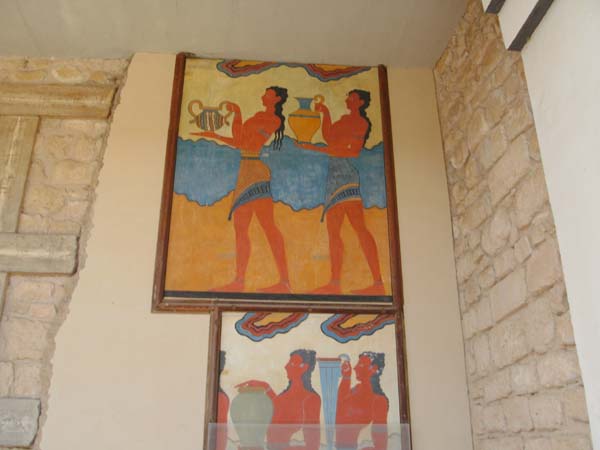

Knossos Viaduct
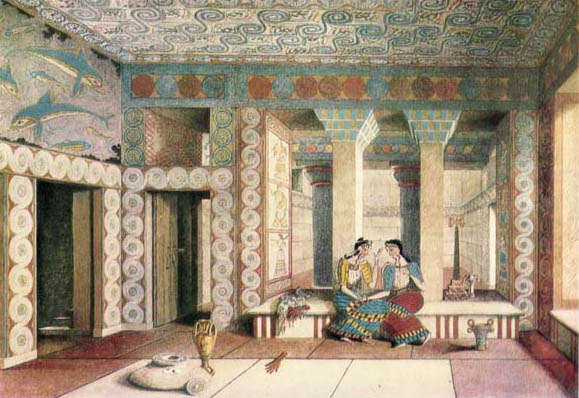
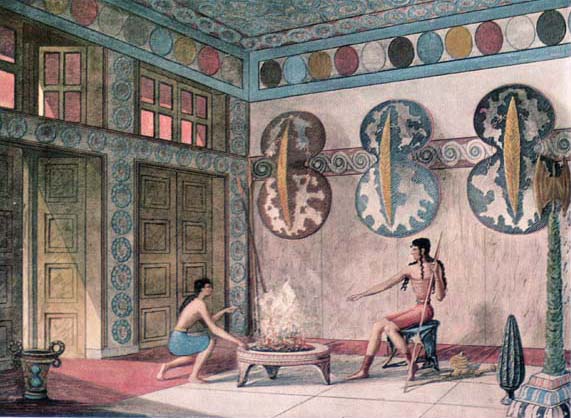

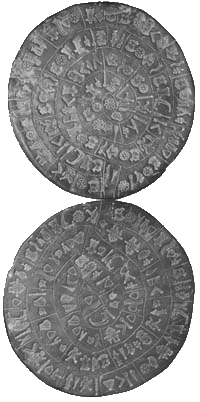 Dagon-Jah removes his roll-away and opens it. He takes from it his masterpiece, a tiny, clay two-sided disk, and hands it to Daedalus. Now it is Dagon-Jah who could laugh at the astonishment on Daedalus's face but he is too gratified to laugh. Inside him well up feelings of joy.
Dagon-Jah removes his roll-away and opens it. He takes from it his masterpiece, a tiny, clay two-sided disk, and hands it to Daedalus. Now it is Dagon-Jah who could laugh at the astonishment on Daedalus's face but he is too gratified to laugh. Inside him well up feelings of joy.













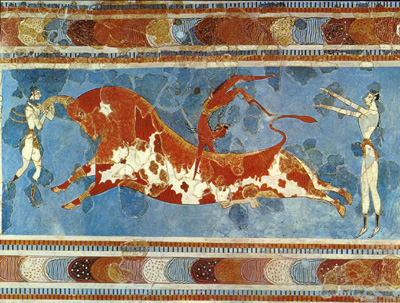
Minoan Bull Leaping
